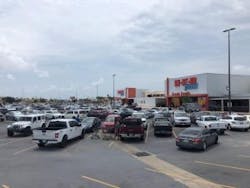Texas on the Verge of an Energy Catastrophe: How Microgrids are Helping
The electric grid has been around for nearly 140 years, but it’s yet to overcome its biggest nemesis: the weather. Texas is showcasing that point this week as it suddenly rivals California in proving the need for microgrids.
What happened in Texas and how bad is it?
Very bad. Struggling to keep the grid from collapse, the grid operator has instituted rolling blackouts causing millions of Texans to lose electricity as bitter cold sweeps the state. Meant to last minutes, the power outages are elongating into hours and possibly days.
As of Tuesday morning, more than 4.3 million electric customers lacked electricity brought about by what could go wrong did go wrong.
It all started when severe and unusual cold caused power demand to rise as households consumed more energy to try to stay warm. The system set a new winter peak of demand of 69,222 MW.
Big power capitulates to the cold
Then, in rapid progression around 11 p.m Sunday night, large power plants began to trip off-line, which they are more apt to do under severe demand and in extreme cold. But the number that failed was staggering. The system lost 34,000 MW, most of them thermal or nuclear plants. Some wind farms also lost productivity as turbines succumbed to icing.
The system reached a point where “electric demand was really just exceeding available supply,” said Dan Woodfin, senior director of system operations at ERCOT, the grid operator for most of Texas.
At this point the reliability of the entire grid was in jeopardy. If an electric grid goes out of balance, it risks wide-scale blackouts. So to reduce demand, ERCOT instituted its highest energy emergency alert, which called upon utilities to begin controlled blackouts. These are temporary power outages, generally lasting minutes, meant to ease pressure on the grid.
However, some Texans are experiencing much longer power outages for various reasons. There are the usual storm-related mishaps — ice and wind taking down distribution lines. Or, in other cases, as Woodfin noted, utilities are shutting down circuits to noncritical customers to ensure hospitals and other emergency services receive power.
Meanwhile, ERCOT continues to struggle to keep the grid in balance as power plant operators work to bring their units back online.
Exactly what went wrong and when will become clear in the coming days and weeks as the Texas power system is put under the microscope.
One thing is immediately apparent. Microgrids are helping ease the problem, but Texas doesn’t have enough of them.
How microgrids help grids
“This is another great example of where microgrids can not only provide resiliency for their respective customers but also alleviate some of the load on the grid, allowing the utilities to maintain their own system reliability,” said Michael Bakas, executive vice president at Ameresco.
He noted that if there were more microgrids – if they reached a critical mass – they could become a larger resource for utilities to call upon during periods of potential disruption.
“The utilities could reach out and request the microgrids to island. That would reduce the utilities’ load requirements and could potentially allow them to avoid rolling outages. This is a good example of where microgrids and utilities can coexist and benefit from each other,” he said.
Or, as Mike Byrnes, senior vice president, Veolia North America put it: “At times of grid stress, the resiliency and societal benefits of microgrids really shine through.”
Byrnes, whose company focuses on microgrids that use combined heat and power, said that such systems “will keep the local microgrid customers running while at the same time relieving stress on the grid, benefiting everyone. It is yet another reason that public policy should encourage microgrids.”
Microgrids up and running in Texas
While their numbers are still few, microgrids kicked into action as early as last week when it became apparent a crisis was nearing.
“Every megawatt really matters right now,” said Allan Schurr, chief commercial officer at Enchanted Rock.
Microgrid company Enchanted Rock has about 200 microgrids in Texas. Of those 200, about 130 have been supplying capacity to aid the grid. under the most recent tally. (The power situation is fluid and changing in Texas by the hour.)
Photo courtesy of Enchanted Rock
Therefore, about 70 of Enchanted Rock’s customers had onsite microgrids that kept electricity flowing to their premises as they were experiencing grid outages. Many of these are stores that were able to stay open to supply food, prescriptions and gas during the crisis. Among Enchanted Rock’s microgrid customers are Buc-ee’s, H.E.B. and Walmart stores.
Enchanted Rock also provides power for other kinds of facilities, such as assisted living.
“I saw a note from a customer thanking us for our support of their operation because they don’t have to worry about evacuating their patients or residents,” Schurr said
Enchanted Rock monitors and operates its microgrids from remote network operations centers. During the storm, teams have been sleeping at the centers.
“We have very high availability amongst our generators. The engineering team and our NOC operators, something like 80 people, working really nonstop since last Thursday to make sure we have all the availability we can muster there… even sleeping in the network operation center. Twelve hours on, 12 hours off kind-of-thing,” Schurr said.
Ample fuel for microgrids during blackouts
The company uses natural gas to run its microgrids. Despite reports of storm-related natural gas shortages in Texas, Enchanted Rock has seen no supply disruptions, which Schurr attributes to its firm supply agreement and ability to take gas at low distribution volumes behind city gates.
He also credited an emergency decision Friday by the Texas Railroad Commission to give generators a priority position in the queue for natural gas. The state commission, which has jurisdiction over alternative fuel safety, natural gas utilities, surface mining and intrastate pipelines, placed power plants in second place, just behind homes, residences, hospitals, schools and churches, and ahead of commercial and industrial facilities and other natural gas users.
Schurr argued that the grid crisis shows the value of a system that includes many small, distributed power systems, rather than a 1,000 MW plant that can go down “all in one fell swoop.”
Enchanted Rock isn’t the only microgrid provider busy because of the winter storm, which is affecting a large swath of the US. The Southwest Power Pool also called its highest level of emergency for 14 states on Tuesday.
“We’re generating across several states for emergency grid relief providing our customers good return on investment while we help our utility partners stabilize the grid,” said Debra Phipps, director of PowerControl 24/7 at PowerSecure, a subsidiary of Southern Company.
PowerSecure won praise from one of its Texas customers, AmerisourceBergen, a global pharmaceutical services company that has a 2,500 kW Tier Four diesel microgrid at its Carrollton, Texas, facility. “When acute events such as extended periods of high temperatures or surprise cold snaps occur, you want a business partner you can trust.”
Like an insurance policy
By NicoElNino/Shutterstock.com
Reliability is a key microgrid benefit during the kind of outage faced by Texas, but so is price management. Wholesale power prices have skyrocketed because of the electricity shortages, reaching ERCOT’s market cap of $9,000/MWh. To put that in perspective, the average annual price in Texas is about $30/MWh.
Microgrid owners can earn or save money during these periods by providing much-needed services to the grid or by using on-site power from the microgrid to avoid paying the high grid costs.
“Microgrids are sometimes thought of too narrowly, as protecting from wildfires or from weather related outages in general. But microgrids are actually more like an insurance policy protecting you from any type of event, natural and otherwise, that may disrupt power flow. The fun part about microgrids is that this insurance policy can reduce costs and save money, too,” said Scott Kessler, who handles microgrid strategy and sales for Siemens.
Learn more about how microgrids serve during disasters. Join us at Microgrid 2021! Advanced registration is free but space is limited.
That insurance is likely to become more important in the face of climate change. And, as Mark Feasel, Schneider Electric’s president for smart grid, North America, pointed out, microgrids also have a role to play in mitigating climate change.
“It continues to be proven that weather challenges can hit anywhere. The required portfolio of digitized, decarbonized and decentralized is essential to address our energy transformation. The greening of the grid is not enough when it comes to our resiliency needs. The decentralization of behind-the-meter microgrids provides the facility the resilience required while decreasing their overall carbon footprint,” he said.
A humanitarian technology
But, ultimately, the immediate concern now is keeping the population safe as some see the temperatures in their homes, with no heat or power, dip dangerously low. More microgrids in communities, shelters or even homes could help.
“We hope this terrible large-scale power outage in Texas is quickly resolved, and it reminds us how resilient power delivery is critical to life safety and the functioning of society in today’s world. Strengthening distribution grids and adding robust advanced microgrids at critical locations can help mitigate the humanitarian and economic impacts of unexpected, cascading disruptions like the ones we’re seeing,” said Erik Svanholm, vice president, non-wires alternatives at S&C Electric Company.
“There is, of course, a lot more to say, as this event is instructive,” he added. “The technical term for microgrid resiliency is ‘contingency handling,’ meaning the system’s ability to stay online and automatically shift power output among different sources when connected equipment starts failing (in this case, due to extremely low temperatures.) This outage is unfortunately a perfect example of the importance of strong contingency handling for power systems at every level, from transmission to distribution to microgrids. But at the moment I’m mainly concerned about people staying warm.”
Track news about Texas microgrids by subscribing to the free Microgrid Knowledge Newsletter.
About the Author
Elisa Wood
Editor-in-Chief
Elisa Wood is the editor and founder of EnergyChangemakers.com. She is co-founder and former editor of Microgrid Knowledge.


